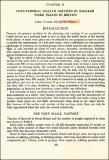Occupational Health Services in Smaller Work Places in Britain
Publication Date
1957Type
Book chapterviews
downloads
Metadata
Show full item record
Abstract/
PERHAPS the greatest problem in the planning and running of an occupational health service on a national basis is how to meet the health needs of the smaller work places. A small work place may be defined for our purposes as one too small to justify the employment of a full-time nurse. Such a definition has the practical vantage of covering all working groups whose needs must be met on a collective ~¥is . It also includes all kinds of work places- factories, warehouses, building sites, mines, docks, farms, offices and shops. Some of these are covered in part by ~cial legislation such as the Factories Acts or the Shops Act, but others are not. he point at which a full-time factory nurse is needed depends as much on the natu e of the work done as on the numbers employed. Thus, a heavy engineering works with 500 or less employees may provide enough work to keep a nurse fully occupied on nursing duties. By contrast, the needs of a factory employing 800 workers engaged in light electrical assembly may be fully met by two one-hour nurse sessions a day supplemented by adequate first-aid and emergency arrangements. In Great Britain, over 60 per cent of the factory population work in factories employing less than 500 people. The bulk of commerce is made up of small shops and offices, and even in the coal-mines 13 per cent of miners work in pits employing less than 500. It is clear, therefore, that a large proportion of the total working population, in factories and elsewhere, come within our definition. The activities of small working units are almost as diverse as those of industry and commerce as a whole. Only massive production lil\es and the manufacture of major capital equipment are excluded. The health hazar<'ts and needs arising in the smaller work places do not differ substantially from those in the larger places. But because of the scatter and number of the working units, they can only be fully appreciated when the units are viewed collectively.
Subject/
Occupational health; Work place; Britain; Factories; Occupational health; Trauma; Population; Engineering; Health hazard
Further Details
Chapter 19
Collections
- Book Chapters [14]

